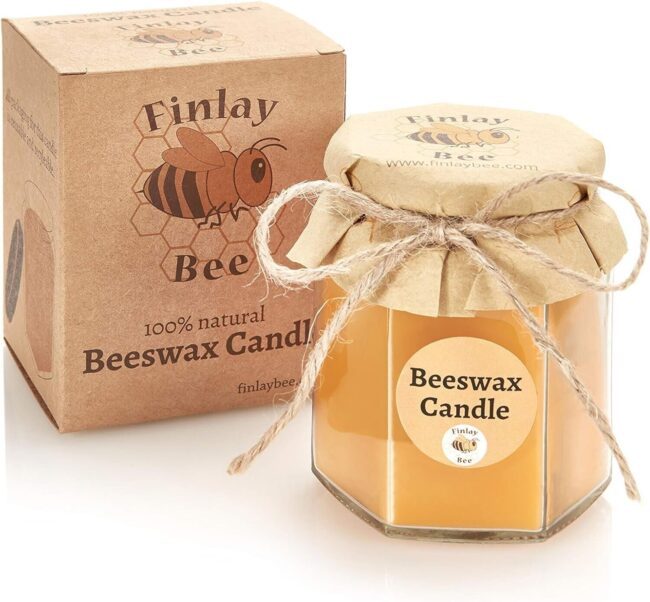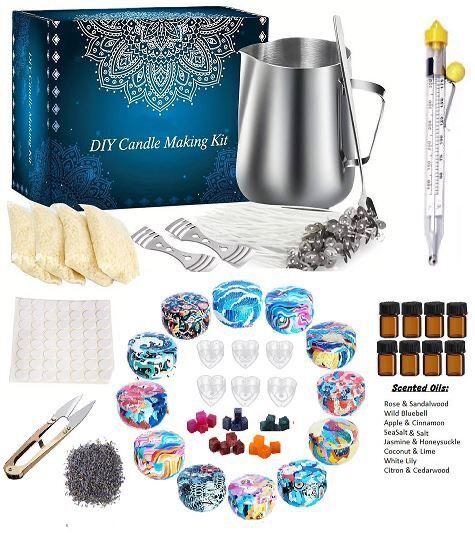Hidden Toxins In Candles
Ever wonder why that delightful candle scent gives you a headache? That’s probably due to hidden toxins lurking in your favourite candles. Many everyday candles contain harmful substances that can mess with your health without you even knowing. What seems like a harmless flicker of light can be a source of indoor air pollution, often more harmful than outdoor smog.

Let’s break it down. The most common culprits include paraffin, lead wire wicks, and synthetic fragrances. Paraffin is a byproduct of petroleum, coal, or shale that releases nasty stuff like toluene and benzene when burned.
Lead wire wicks can release lead particles into the air, something you don’t want in your lungs. Synthetic fragrances? They often contain phthalates, which aren’t favouring your body. These ingredients are frequently chosen because they are cheap and effective but come with hidden costs to your health and environment.

These toxins can lead to health issues like headaches and dizziness and even long-term effects like respiratory problems and hormone disruption. Yikes! Research shows that burning candles with these chemicals can significantly lower indoor air quality. Nobody wants that in their home. And it’s not just limited to immediate symptoms; prolonged exposure can worsen pre-existing conditions such as allergies and asthma, making everyday life more uncomfortable.
Being asthmatic, I am particularly mindful when selecting candles to light in my home. Some fragrances and types of candles, especially those made with synthetic scents or paraffin wax, can release irritants that trigger my asthma and affect my breathing. I always look for candles with natural ingredients, such as soy or beeswax, and opt for gentle, non-irritating scents to create a cosy atmosphere without compromising my respiratory health. This careful selection helps me enjoy the ambience of candles while keeping my airways safe and comfortable.
Related Article: Well-Being Candles
Shocking stats back this up. One study found that candles release pollutants that could exceed outdoor air pollution standards. Yep, that’s right – lighting a candle inside could be worse than breathing the air outside on a smoggy day.
Real-life stories and case studies also shed light on this hidden hazard. People have reported everything from mild headaches to severe respiratory issues linked to candle use. These personal accounts are a stark reminder that what you burn in your home matters more than you think.
Related Article: Different Types Of Candles
From Production to Your Home: How Harmful Toxins Make Their Way into Candles
Candles might look harmless and relaxing, but their journey from the factory to your living room can introduce unwanted guests into your air. The production process often involves materials and practices that contribute to toxic exposure. It’s not just about what goes into the candle; it’s also about how those ingredients are handled and processed.

First up, raw materials. Many mainstream candle brands use paraffin wax, a cheap but dirty petroleum byproduct refined with chemicals that can end up in the final product. Then there’s the wick. Sounds simple, right? Not always. Some wicks have been found to contain lead or other metals. When burned, these can release heavy metal particles into your home. Even wicks labelled as ‘safe’ may sometimes contain traces of harmful substances, slipping through regulatory cracks.

Additives and scents are another primary concern. Synthetic fragrances give candles alluring scents but often contain phthalates and other hazardous chemicals. These can cause everything from headaches to hormone disruption. Dyes and colourants used in candles can also release harmful substances when burned. Every time you light a candle, you might release a cocktail of toxic chemicals into the air, accumulating over time.
Regulations are supposed to protect us, but there’s a catch. Current standards for candle production vary widely and often miss essential safety checks. Some regulations don’t account for the cumulative effects of burning these toxins over time. And it’s not like a big, bold warning label on most candle packaging. This lack of transparency makes it difficult for consumers to make informed choices, inadvertently exposing them to unnecessary health risks.
Experts in the industry and toxicology report that many companies skirt the rules due to a lack of enforcement and oversight. Some even label their products as ‘natural’ or ‘eco-friendly’ despite containing synthetic ingredients. Consumers need to stay informed and cautious when picking out candles. It’s a tricky terrain, but knowledge is power. Awareness is the first step toward making safer choices and holding brands accountable for their products.
Related Article: Foton Pearled Candles
Health and Environmental Impacts: Why You Should Care About Candle Toxins
Breathing in toxins from candles isn’t just an abstract danger. It has real health repercussions. In the short term, you might notice headaches, dizziness, or even exacerbated asthma symptoms. In the long term, candle toxins can lead to serious respiratory issues and other chronic health conditions. Children, the more mature, and those with pre-existing health conditions are particularly vulnerable to these harmful effects, making it even more crucial to pay attention to the candles we use.
I’m often drawn to candles with beautiful designs, colours, or stylish packaging, and I sometimes find myself tempted to buy them simply because they look so appealing. The aesthetic appeal can be hard to resist, whether it’s a stunning jar, a unique shape, or a colour that matches my home decor.
However, as someone with asthma, I must remember that not all pretty candles are safe for breathing. Even the most attractive candle can contain ingredients that might irritate my lungs, like synthetic fragrances or harmful waxes. So, while the look of a candle is essential, I always check the ingredients to ensure they won’t compromise my health.
When you light a candle, you’re not just creating a cosy atmosphere but also affecting indoor air quality. Burning candles releases pollutants like toluene and benzene, which can linger in the air long after the flame is out. Indoor air pollution is a growing concern, especially for those who spend much time indoors. Poor air quality can significantly impact respiratory health, leading to chronic bronchitis or heart disease. Even occasional use can contribute to a gradual buildup of harmful chemicals in your living space.
But it’s not just about health. Candle pollutants don’t just disappear. They accumulate in your home and can even seep outside, contributing to broader environmental issues. The release of these chemicals can pollute water sources and harm wildlife. In the long run, using toxic candles isn’t sustainable for our planet. Choosing safer alternatives can make a significant difference in reducing your carbon footprint and protecting the environment.
Real stories bring these issues to light. People have shared personal testimonies about how they’ve experienced everything from mild discomfort to severe health struggles linked to candle use. These stories underline the importance of being cautious with everyday products we often take for granted. By learning from others’ experiences, we can make more conscious choices that benefit our health and the planet.
Safer Alternatives and Best Practices: How to Enjoy Candles Without the Risks
You don’t have to give up candles to stay safe. Plenty of options let you enjoy the comforting glow without the hidden dangers. Start by looking for candles made from natural ingredients like soy, beeswax, or coconut wax. These materials burn cleaner and don’t release harmful chemicals. Many of these alternative waxes are also renewable and biodegradable, adding an eco-friendly bonus to your candle-burning experience.
Keep an eye on the wick, too. Opt for candles with cotton or paper wicks. These are safer and don’t emit heavy metals when burned. Sometimes, it’s the little details that make all the difference. Avoid wicks with a metallic core, which can release harmful particles when burned, even if they’re not explicitly labelled as such.
Scents are significant in the candle experience but shouldn’t come with risks. Choose candles scented with essential oils rather than synthetic fragrances. Essential oils provide a pleasant aroma without the added toxins. Look for brands that list all their ingredients, so you know what you’re bringing into your home.
Have you ever considered making your own candles? It’s easier than you might think! DIY candle-making lets you control what goes into your candles, and it’s a fun activity. Use natural wax, pure essential oils, and safe wicks for a personalised, toxin-free candle. Plus, it allows you to customise scents and colours to your liking without the worry of hidden toxins.
Candle Making Kit DIY Candles Craft Tool Set Pouring Pot Wicks Wax Kit Gift
A few simple practices can also help minimise risk when using candles. Ensure your room is well-ventilated, trim the wick to about a quarter inch before each use, and avoid burning candles for extended periods. A little care goes a long way in maintaining a healthy environment. Using a candle snuffer instead of blowing out the flame can also help reduce the release of soot and other particulates.
6 x 100% PURE BEESWAX Pillar Candles ~timeless and eco-friendly

Lastly, check out some eco-friendly brands. Many small businesses specialise in creating sustainable, non-toxic candles. Supporting these companies not only keeps your home safe but also promotes better practices in the industry. Win-win! By choosing these safer alternatives, you can enjoy the warmth and ambience of candles without compromising your health or the environment.
Related Article: Personalised Wedding Candles
Beeswax Candle -Pure Eco-Friendly UK -Sustainably Sourced Glass Jar

Uncover the Hidden Truths: Join Our Newsletter!
Are your favourite candles and perfumes secretly toxic? Don’t let hidden chemicals ruin your vibe! Get the inside scoop on:
Hidden Toxins in Candles: Discover the harmful ingredients lurking in popular home fragrances and how to choose safer options.
Celebrity Perfumes: Find out which celebrity scents are safe and which ones to skip.
2024 Trends: Stay ahead with the latest trends in clean beauty, eco-friendly scents, and non-toxic home decor.
Join our community of savvy readers and start making healthier choices today. Don’t miss out—subscribe now for exclusive tips, product recommendations, and the latest industry buzz!
Sign up now and be the first to know!
Love Writing Blogs? Turn Your Passion into Profit!
If you enjoy sharing your thoughts through blogging, why not make it a business? By joining Wealthy Affiliate, you’ll get access to tools, training, and a supportive community to help you build and grow your website. Whether you’re a beginner or a seasoned writer, Wealthy Affiliate makes it easy to turn your words into income.
Click the box to start your blogging journey today!

